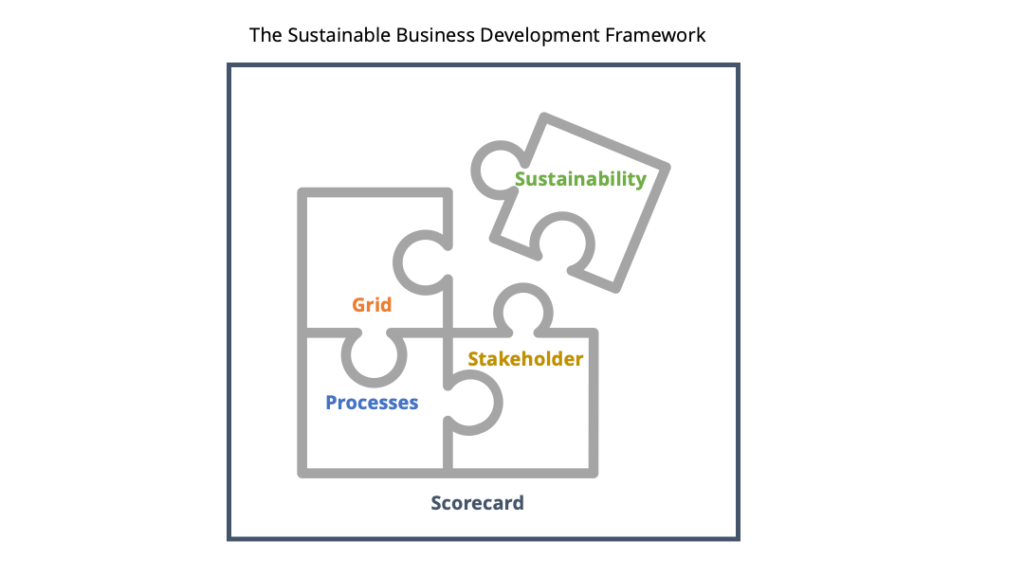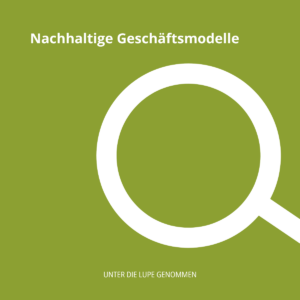An introduction to the five key disciplines.
Reading time: 9 minutes

In this introductory post I will highlight different business development activities, which are dependent on a company’s organizational structure and the personal knowledge and experience of business developers who are doing the job. Finally I will add my definition of an end-to-end perspective.
In the second part of this post, I will give an overview of the five essential disciplines of the Sustainable Business Development Framework, which I will cover in detail in the following blog posts.
What does business development mean?
It was May 2019 in Orlando and a long and exhausting day at a big fair and subsequent get-together event. I was looking for a quiet place to sit down for a few minutes. A very convenient seating area at the corner invited me to take place. After a while, another visitor of the fair came along, obviously tired as well and asked me if he could join. A few minutes later, two more people discovered this quiet seating area and sat down too. We all enjoyed sitting here in absolute silence, no mobile phones, no conversations.
Can you recall the feeling that it gets quite tough to hold silence for a longer period? After 5 minutes eventually, one of the two people who joined last, a young and tall man full of energy broke the silence. “Hey guys I’m Paul, working as a business development executive for a software company in the UK. How are you?”
The man next to me, a white-haired man with the aura of a very experienced business manager, raised his head and responded: “Good, good. I am Michael and I am doing business development for a huge hardware company here in the South of the US. Nice to meet you.”
After a short while the young athletic woman, who joined with Paul, took the chance to introduce herself. “Hi all, my name is Laura. I have recently joined a system integrator company running relationships with software vendors in the UK. I am working a lot with Paul to develop a joint business.”
Finally I introduced myself: “Nice to meet too. My name is Juergen, and I am with a German based software company. My responsibility is to develop new business jointly with a strategic alliance partner and their ecosystem.”
Paul responded immediately: “I would have taken any bet, that you are a German guy.” I asked: “Why.” He responded: “I can’t tell you in detail, but you German guys are always very recognizable out of the crowd.”
The ice was broken. After typical small talk, the conversation turned into an interesting and emotional discussion about business development.
Sales oriented business development
Paul complained:” I am busy working with our partners to find new customer opportunities. And, especially working with Laura, we are quite successful. However, my management asks for more. I am asked to create a plan for scaling better. I am working day and night with partners and customers. I cannot afford to spend much time working on a business development plan and involve all the other internal functions needed. I need to talk to partners and customers. Do you guys have a template that I could use to save my time for the more important work?”
Laura supported Paul in his argumentation: “All the other corporate functions, like marketing or product management, do not listen to me. I have told back office functions many times exactly what I need from them. But instead of providing me what I need, they always come back with other ideas. For example, I have asked marketing to run a UK specific campaign for the retail industry. They denied and told me that is not our strategic market we want to go for. They are currently running an initiative for the financial industry and suggest including my request for customers in this industry. Can you imagine?”
Paul chimed in again, obviously getting very emotional: “Laura and I identified at least three customers which would need a specific feature to get the data query faster. Product management told me that this does not make sense, because the product roadmap prioritizes better integration capabilities.”
Channel oriented business development
I watched Michael for a while squirm in his seat: “You guys think you are doing scalable business development. What I have heard so far is that you are sellers. With my team we are in the middle of creating an open and future minded partner ecosystem organization with extremely attractive partner programs. This will help scaling our business, not only winning customer after customer.”
Paul looked up to Michael, prepared to counter his arguments. Suddenly Laura kicked in and asked me: “Juergen, what is your interpretation of business development?”
Business development from an end to end perspective
My answer provided a third perspective: “I always recognized that there is a disconnection or even a misunderstanding between the two positions, between sales and channel approach. But there is no black and white. For successful business development in my opinion the two approaches need to come together. Plan and execution are indispensable. Different company functions need to be aligned on a common goal. And everyone has to contribute to that. And there has to be someone to oversee this. Looking at it from an end-to-end perspective. It does not really matter in which organizational department. Business Development is team play. And every team needs a captain.”
In the end we could not come to a joint conclusion. During our discussion we understood that the way business development is executed, depends on the organizational structure of the company and the personal knowledge and specific experience of business developers.
My definition of Business Development
Since that discussion I always ask business development people ( doesn’t matter what title they carry), about their understanding of business development.
Most of them have their own understanding, seeing their own roles as the most important part of business development. But seldom end-to-end perspective is taken.
SoI decided to develop a Sustainable Business Development Framework. Based on my experience and on the wise input from dear friends. My goal is to create a collective understanding of the term business development by covering the most critical components from an end-to-end perspective. Before making out these components, let me give my definition of business development.
Business development is the sum all efforts needed to bring a product or solution successfully to the market, identifying customer opportunities by using various routes to market and handing it over to sales for closure.
Juergen L Sommer
Business Development roles & functions
Business development includes a broad range of distinct functions and roles, for example:
- Product & Solutions
- Finance
- Legal
- Marketing
- Partner Ecosystem, including Alliances
- Business Development – if as separate function available
- Sales
Each of these functions have their own processes and goals, but they are rarely well aligned. Therefore, some of the above function need to own the business development role. Or if shared across the organization, roles and responsibilities need to be clearly defined. A mutual understanding and joint agreement to the goals is mandatory. So that all activities can be streamlined across the whole company to increase the company’s business.
Most business development managers can be found in sales organizations, or especially in alliance or partner ecosystem departments. Because of that, often the short- time revenue goals are outweighing the long-term business development aspirations.
The Sustainable Business Development Framework (SBDF)
The use of a mutually agreed Sustainable Business Development Framework helps each organizational party involved in business development getting one the same page. So that everybody understands the bigger picture. The framework can bring down organizational boundaries, foster collaboration, and align the tasks needed to achieve the jointly agreed goals.
These are my five essential disciplines of the Sustainable Business Development Framework, that I will explain in following, individual blog posts.

1. The Grid
The current Channel and Partner Management Systems are outdated. New structures and players require new approaches. Trust is the new ultimate currency. Hard to obtain, and easy to lose.
2. The Agile Business Development Processes
Processes – which enable business in a favorable manner – need to contain both, static and dynamic pieces. Provide consistency but flexible enough to leverage speed of execution.
3. The Unknown Stakeholders
The question is not who you know, it is about who you do not know. The known unknowns and even the unknown unknowns. Everyone plays a key role at a certain point of time. On the playground and beside it.
4. The Sustainability Advantage
Sustainability is not only a strong marketing argument it is becoming a business requirement. The European Union is working on a proposal for the directive on corporate sustainability due diligence. And this will not only affect the supply chain.
5. The Scorecard
In his book ‘The Infinite Game’, Simon Sinek, explains, that infinite games cannot be measured with finite goals. The Sustainable Business Development Framework Scorecard is building a bridge between these opposites.
Sustainable Business Development is a system thinking discipline
I read many articles about generating growth or overcoming obstacles of growth. Most of those focused on isolated topics. For example, market and customer segmentation, or creating a compelling value proposition. Nothing is wrong with that as long as it is seen in an overall context. Initiatives and business areas are connected to each other, one influences many others, while others have strong interdependencies with each other.
The creation of a market and customer segmentation helps to focus on sweet spots or identifying white spaces. But treated isolated it cannot achieve great outcomes. This activity needs to be connected to a competitive analysis of the market and consider available distribution channels and programs. The value proposition of the same product can be different for each customer segment, or for each distribution channel.
Only a limited amount of the world’s population can think through systems with an end-to-end perspective. This is not a blame; it is a fact. The dilemma is that most business developers in charge are not able to recognize that things are isolated and not connected. They may be successful anyway without knowing and applying this end-to-end perspective. Focusing on their individual strengths, they achieve their targets anyway, so why should they care.
So, why should business developers make huge efforts and collaborate with many more people when not needed to reach their goals?
Because this system thinking will foster sustainability. One of the basic principles of sustainability is the understanding that everything is connected and influences each other. Sustainability is fundamental to be successful in the long term, focusing on short term success only is not.
Sustainable Business Development requires strong leadership
Why is Sustainable Business Development so difficult to execute?
Because it doesn’t have clear boundaries, and in many cases no defined owners.
Sustainable Business Development is not only about creating a plan, but also an ongoing activity, which needs to be adapted constantly if changes occur. This can be internal changes in product, service, go-to-market, sales channels, or organizational changes. These changes can also be driven by external factors, like changes in market, competition, regulation, and others.
Creating a Sustainable Business Development Plan for the first time takes a lot of effort. Many people from different organizational functions have to be involved to provide specific information, structuring it, applying various business frameworks and scientific models, and concluding the right priorities and goals.
This requires a strong leader with excellent communication skills, who oversees business development from end-to-end.
Typically, those appointed leaders will be business development managers or partner/alliance managers, in addition to their day-to-day tasks. Most of them have the best experience in their current job responsibilities, like sales, partner management or marketing but less knowledge for covering the overarching disciplines of business development.
Furthermore, they are bounded in their own organizations. This factor can entail imbalanced planning. So, salespeople might put more emphasis on sales topics, partner managers on relationship topics and marketing people on demand generation activities.
The business development leader has to be empowered by the organization and has to be strong enough to make unpopular decisions, especially when it comes to the interests of his own department. During all phases, from planning to execution.
I would appreciate if you join me on the journey for the five key essential disciplines of the Sustainable Business Development Framework, which will be explained in my following blog posts.


